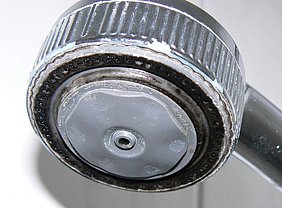The objective of the DVGW-funded study on the occurrence of black biofilms on drinking water taps was to assess the presence and relevance of black biofilms based on a literature survey and an evaluation of current cases, and, if necessary, demonstrate a need for further research.
For several years, the isolated occurrence of black biofilms have been reported on taps in drinking water installations. The black biofilms are primarily discovered on jet controls and shower heads. After removal, the biofilms usually reform within a few weeks. The objective of the DVGW-funded study was to assess the presence and relevance of black biofilms on drinking water taps based on a literature survey and an evaluation of current cases, and, if necessary, demonstrate a need for further research. Researchers evaluated 88 cases from 29 supply areas.
The results of the research can be summarised as follows:
- The black biofilms appearing on taps in drinking water installations were colonisations of bacteria and fungi, with black yeasts being the most predominant.
- Based on current knowledge, black yeasts are not relevant to health.
- Black yeasts are widespread in the environment and are present in groundwater and surface water, with a higher load expected in surface water.
- In drinking water treatment it is possible to reduce and increase their concentration. Irrespective of the raw water basis and the type of treatment, general fungi or fungal spores are present in drinking water, in various concentrations, though low compared with the bacterial count. Propagation in the distribution system and drinking water installation is not suspected due to the low nutrient content and there is no evidence of this to date.
- Black yeasts identified in the black biofilms on taps may certainly come from drinking water, although it is more likely to be a case of the affected places being inoculated with fungal spores from the surrounding air.
The evaluation of the current cases showed a clear correlation between the dosage of inhibitors containing phosphonates and the occurrence of black biofilms. We can conclude from this that fungal growth in drinking water is subject to inorganic limitation by phosphorus, which is cancelled out by the inhibitor dose. It also requires the growth of organic nutrients. Possible sources include releases from organic substances from unsuitable materials and organic substances in the ambient air, for example from using cosmetics.

![[Translate to English:] Prüfstelle-Produktprüfung_Teststand Test centre and product testing](/fileadmin/_processed_/0/9/csm_TZW-Karlsruhe_Pruefung_Geraete-Teststand_377188946c.jpg)
























